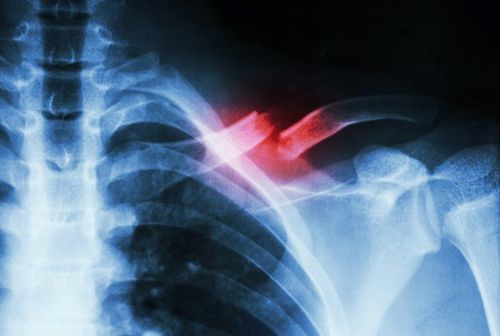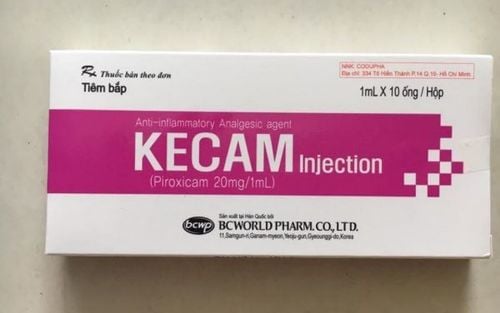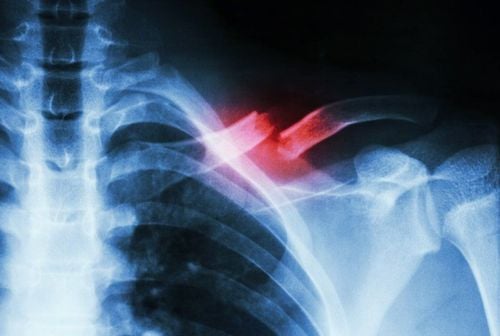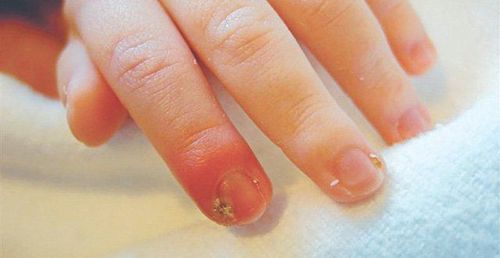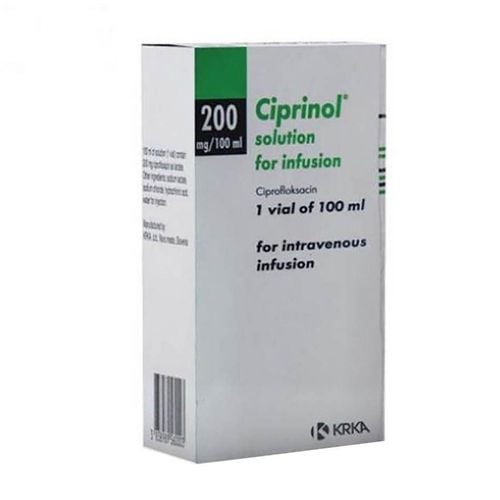This is an automatically translated article.
Fracture occurs when more force is applied to the bone than the bone can bear. Fractures can occur from excessive trauma, falls, trauma, or direct impact to the body. The following article will help you better understand the effects of fractures in children, as well as the signs to recognize and prevent fractures in children.
1. Children's bone structure
Children are in the development stage, so bones are usually soft and easily bent, have many pores, can withstand deformation and compression. Children's bones themselves can be straightened, but not all bones in the body are like that
Children's bones are more resistant to displacement and easier to heal than adult bones. In fractures in children, the rate of damage to the synovial cartilage between the two bones accounts for 10-15%, rarely fractures except for strong injuries. The synaptic cartilage is weaker than the ligaments that surround joints and tendons. With the same force of impact, an adult can split or tear a ligament or dislocate a joint, but with a child, the impact can damage the synovial cartilage leading to a disorder of bone development.
Characteristics of children's bones with fractures have the ability to stimulate bone growth by itself by increasing blood supply to the synaptic cartilages.
Children's bones heal faster than adult bones due to the continuous ossicles and abundant blood supply. The younger the child, the sooner the bone heals (newborns have a healing time of about 2 - 3 weeks, 7 - 10 years old this time is 6 weeks, and children over 10 years old are from 8 - 10 weeks). Non-healing in children is rare or even non-existent (except for some very severe injuries that cause open fractures, osteomyelitis, or pathology). The surgery to correct the fracture is not indicated for children because it will affect the cartilage that heals the bone.

Gãy xương ở trẻ em có thể xảy ra do chấn thương quá mức
2. Types of fractures in children
Broken bones can be in many different ways. Most fractures are caused by mild to moderate trauma, such as a fall or a direct blow while a child is playing or participating in sports. If more force is applied to the bone than the bone can absorb, it will break or warp. The amount and type of force will affect the type of fracture.
Nondisplaced fracture With a nondisplaced fracture, the bone is usually in a position where it can be healed. Such fractures are usually treated with a splint or cast. This immobilizes the injured bone, promotes healing, and reduces pain and swelling.
The following types of fractures can be treated with a splint, splint or cast:
Single fracture without displacement : The bone is cracked or broken but remains in place. Stress fractures (hairline fractures): Small cracks that form in bones, often as a result of overuse or repetitive motions under pressure. Stress fractures are common in children who run track or participate in gymnastics or dance. Traumatic fracture or fracture: One side of the bone is curved (buckled) into itself. The bone is dented but not broken. This is a common injury in young children, usually from a simple fall. Dislocation fractures When the fracture is displaced, the ends of the bones have shifted outwards. In such cases, the broken bone needs to be straightened in order for it to heal. This is called reduction. After reduction, the injured limb is immobilized with a splint, brace, or cast while the bone heals. If reduction is unsuccessful, other treatment may be needed.
Types of displacement fractures include:
Angle fracture: The two ends of a broken bone are tilted at an angle to each other. Fluid fracture: The ends of the bone are displaced out in alignment Radial Fracture: The bone rotates (rotates) when it breaks. Collar fracture: One side of the bone is broken causing the other side to bend. Broken green stick is like a broken branch. The branch was cracked on one side but partially intact on the other. Other serious fractures Some fractures need to be reduced or surgically removed, or the bone will not heal. Examples include:
Traumatic fracture: A bone broken into more than two pieces that no longer align. Compression fracture: The bone collapses under pressure. This is most severe when it involves the joint surface. Growth plate fractures Growth plate fractures are often caused by extreme force during sports or playground accidents. Depending on the severity of the fracture, they may be treated with a splint, cast, or boot. Some severe growth plate fractures require surgery.
In rare cases, growth plate fractures can slow growth of the affected leg or arm. Damage to the growth plate can also cause the limb to develop at the wrong angle. When surgeons operate on broken limbs in children, they must protect the growth plates as much as possible.
Open and closed fracture Fractures are classified as open or closed. A closed fracture occurs when the bone is broken, but the skin is still intact. An open fracture, also known as a compound fracture, occurs when a bone breaks through the skin. Open fractures are very rare. They can become infected if not treated appropriately and require immediate surgical care.
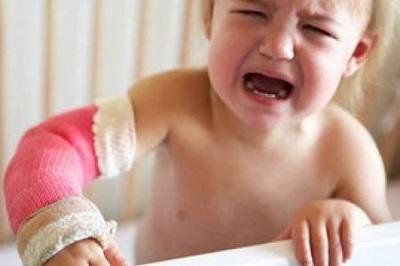
Hầu hết các trường hợp gãy xương là do chấn thương nhẹ đến trung bình
3. When to worry about a child's fracture?
When children play hard or engage in vigorous or high-speed physical activities such as cycling or skateboarding, they can fall hard and break bones. Fractures are a common trauma in childhood, with 40% of girls and 50% of boys.
Fracture rates peak between the ages of 11-15, a time when children's growth spurts during puberty and the amount of minerals needed to keep bones strong often can't keep up with bone growth. Fractures of the forearm are the most common fractures in children, accounting for up to 50% of all fractures, and are much more common than fractures of the leg. This is because the reflex is normally used to reach out to support yourself when you fall.
There is usually no cause for concern in the majority of childhood fractures because they heal quickly after a cast. Some fractures may need to be immobilized by an orthopedist to improve bone alignment. However, children who experience certain types of fracture, especially from minor trauma or repeated fractures, may need to be evaluated by a pediatric metabolic bone specialist.
There are also genetic bone disorders or underlying medical conditions that can cause brittle bones in children, making them more susceptible to fractures. These medical conditions or bone disorders can be treated to improve bone strength and prevent risks.
Types of fractures that should be evaluated by an osteopathic physician include: Low-impact or fragile fractures: The child may have a pathological fracture, which is a fracture that does not occur in healthy bone but in weak bones. These fractures may signal underlying metabolic disturbances of the bone. They are usually the result of a minor injury, such as a fall from a standing height or lower, falling from a chair, or occurring during everyday activities (such as stepping onto the curb).
Femur or femur fracture: These two long bones are very strong and usually do not break easily unless the trauma is severe (such as in a car accident). Breaking these two long bones could be a sign of metabolic bone disease.
Recurrent fractures: If your child has had two or more fractures before age 10, or three or more fractures before age 19, you may consider having your child checked out.
Vertebral Compression Fracture: Unless there is a significant back injury, a fracture of one or more compressed vertebrae is a sign of osteoporosis or metabolic bone disease.
4. Effects of fracture in children
If your child has a fracture, they will need to limit movement at the injury site to give the bone time to heal. Therefore, it will have a significant impact on the spirit as well as the learning and playing of children.
Some fractures may require a splint or splint (partial cast), immobilized with a bandage. A splint or partial cast helps support the injured area, allows the area to rest and heal, and helps relieve your child's pain. Generally, you don't have to wear a splint or partial cast for as long as a full cast.
A cast is needed for three weeks to three months depending on the type and location of the injury - your doctor will estimate how long it will take. The fact that the child is in a cast can make other children tease and make the child ashamed and self-deprecating.
If the injury causes the bone to move out of place in some cases, the surgeon will need to move the bone back into an anatomical position. These procedures are usually performed under sedation or anesthesia in the emergency department or operating room. Fractures that want to be reduced will need to be in a full cast for the wound to heal. Your baby will be in a full cast for up to three months, depending on the injury.
Surgical procedures will inevitably cause complications such as: Sock, open fracture, frame compression, cyanosis due to too tight bundle. An early complication can cause a nutritional disorder, Volkmann syndrome. Late complications can lead to, axial malposition and dislocation of bones; nerve paralysis due to limited mobility; inflammation of the bone; prosthetic joints; destruction of the head or the head of the cartilage.
You should take your baby to a reputable medical facility for examination and treatment. Pediatrics Department at Vinmec is one of the few multi-specialty hospitals with a full range of doctors specializing in neurology, cardiology, gastroenterology, nutrition, psychology, endocrinology, and hepatobiliary care, helping to quickly and promptly handle the disease. detect diseases during the examination. As a key area of Vinmec Health System, Pediatrics Department always brings satisfaction to customers and is highly appreciated by industry experts with:
Gathering a team of leading pediatricians: including leading experts with high professional qualifications (professors, associate professors, doctorates, masters), experienced, worked at major hospitals such as Bach Mai, 108.. Doctors All are well-trained, professional, with a mind - range, understanding young psychology. Besides domestic pediatricians, the Department of Pediatrics also has the participation of foreign experts (Japan, Singapore, Australia, USA) who are always pioneers in applying the latest and most effective treatment regimens. . Comprehensive services: In the field of Pediatrics, Vinmec provides a series of continuous medical examination and treatment services from Newborn to Pediatric and Vaccine, ... according to international standards to help parents take care of their baby's health from birth to children. from birth to adulthood Specialized techniques: Vinmec has successfully deployed many specialized techniques to make the treatment of difficult diseases in pediatrics more effective: neurosurgery - craniofacial surgery, stem cell transplantation. blood in cancer treatment. Professional care: In addition to understanding children's psychology, Vinmec also pays special attention to the children's play space, helping them to play comfortably and get used to the hospital environment, cooperate in treatment, improve the efficiency of medical treatment.
Please dial HOTLINE for more information or register for an appointment HERE. Download MyVinmec app to make appointments faster and to manage your bookings easily.
References: qualitychildrens.org, rch.org.au



